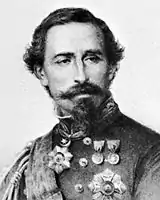| |||||||||||||
All 443 seats in the Chamber of Deputies 222 seats needed for a majority | |||||||||||||
|---|---|---|---|---|---|---|---|---|---|---|---|---|---|
| |||||||||||||
| |||||||||||||
General elections were held in Italy on 22 October 1865, with a second round of voting on 29 October.[1] It was the second one in the history of Italy.
Electoral campaign
The Historical Right was led by the former Prime Minister of the Kingdom of Sardinia, Alfonso Ferrero La Marmora, a long-time general who fought during the Italian unification.
On the other hand, the bloc of the Historical Left was led by Urbano Rattazzi, a liberal politician who was between the founders of the Italian left-wing parliamentary group.
In opposition to the two main blocs there were a third party known as The Extreme, a far-left coalition, under the leadership of Giuseppe Mazzini, an Italian revolutionary and a key figure of the Unification.
On 22 and 29 October only 504,263 men of a total population of around 23 million were entitled to vote.[2] Right-wing candidates emerged as the largest bloc in Parliament with around 41% of the 443 seats.[3] They were largely aristocrats representing rentiers from the north of the country, and held moderate political views including loyalty to the crown and low government spending;[4] the general La Marmora was appointed Prime Minister by the king Victor Emmanuel II.
Parties and leaders
| Party | Ideology | Leader | |
|---|---|---|---|
| Historical Right | Conservatism | Alfonso Ferrero La Marmora | |
| Historical Left | Liberalism | Urbano Rattazzi | |
| Historical Far Left | Radicalism | Giuseppe Mazzini | |
Results
| Party | Votes | % | % of seats | |
|---|---|---|---|---|
| Historical Right | 41.2 | |||
| Historical Left | 35.2 | |||
| Historical Far Left | 3.5 | |||
| Others | 20.1 | |||
| Total | 100 | |||
| Valid votes | 259,035 | 95.26 | ||
| Invalid/blank votes | 12,888 | 4.74 | ||
| Total votes | 271,923 | 100.00 | ||
| Registered voters/turnout | 504,263 | 53.92 | ||
| Source: Nohlen & Stöver | ||||


